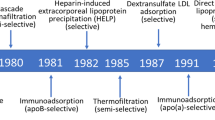Abstract
This study investigated the effect of extracorporal lipid-lowering therapy by low-density lipoprotein (LDL) apheresis on coronary artery disease in a population characterized by early development and rapid progression of atherosclerosis. We treated 32 patients aged between 15 and 63 years with drug-refractory familial hypercholesterolemia, treated once a week by immuno-specific LDL apheresis for 3 years in a controlled prospective and non-randomized trial; 25 patients (14 females and 11 males) completed the study. Noninvasive data were obtained by physical examination, 12-lead ECG and exercise testing. Invasive cardiological data were obtained by cardiac catheterization according to a standardized protocol in four cardiological centers. Left ventricular ejection fraction was calculated using planimetry. Coronary stenoses were measured quantitatively in 23 defined coronary segments by a panel of four investigators with an electronic digital caliper. In addition, overall coronary atherosclerosis was visually qualified. Final decisions on a classification into one of three groups (regression, no change, progression) of coronary atherosclerosis were based on panel consensus. Six cardiac events occurred throughout the study: percutaneous transluminal coronary angioplasty in one patient, coronary bypass grafting in three and two deaths. Statistical analysis of exercise testing yielded no significant change for maximum power and work capacity during the study period. Hemodynamic data revealed no significant change; mean ejection fraction was calculated as 65.8 ± 15.9% at study entry and 67.0 ± 12.7% at completion. Quantitative measurement of 111 circumscribed coronary stenoses showed a mean stenosis degree of 45 ± 26% at entry cineangio-film and 43 ± 22% at final cineangio-film demonstrating no significant change. Eight localized stenoses showed a regression of more than 10% and 11 stenoses a progression of more than 10%. Panel consensus decision for overall coronary atherosclerosis resulted in regression in no patients, no change in 16, questionable progression in 3, definite progression in 5, and undecided in one. We conclude that specific LDL-apheresis therapy can be used effectively for primary and secondary prevention of coronary artery disease in patients with familial hypercholesterolemia. Its beneficial effect was the prevention of further progression of coronary artery disease in the majority of the study population.
Similar content being viewed by others
Abbreviations
- FH:
-
familial hypercholesterolemia
- LDL:
-
low-density lipoprotein
References
Barth JD, Arntzenius AC (1991) Progression and regression of atherosclerosis, what roles for LDL-cholesterol and HDL-cholesterol: a perspective. Eur Heart J 12: 952–957
Blankenhorn DH, Nessim SA, Johnson RL, Sanmarco ME, Azen SP, Cashin-Hemphill L (1987) Beneficial effects of combined colestipol-niacin therapy on coronary atherosclerosis and coronary venous bypass grafts. JAMA 257: 3233–3240
Borberg H, Gaczkowski A, Hombach V, Oette K, Stoffel W (1988) Treatment of familial hypercholesterolemia by means of specific immunoabsorption. J Clin Apheresis 4: 59–65
Brown G, Albers JJ, Fisher LD, Schaefer SM, Jiin-Tarng L, Kaplan C, Xue-Qiao Z, Bisson BD, Fitzpatrick VF, Dodge HT (1990) Regression of coronary artery disease as a result of intensive lipid lowering therapy in men with high levels of apolipoprotein B. N Engl J Med 323: 1289–1298
Cashin-Hemphill L, Mack WJ, Pogoda JM, Sanmarco ME, Azen SP, Blankenhorn DH (1990) Beneficial effects of colestipol-niacin on coronary atherosclerosis. JAMA 264: 3013–3017
Fisher LD, Judkins MP, Lesperance J, Cameron A, Swaye P, Ryan T, Maynard C, Bourassa M, Kennedy JW, Gosselin A, Kemp H, Faxon D, Wexler L, Davis KB (1982) Reproducibility of coronary arteriographic reading in the Coronary Artery Surgery Study (CASS). Cathet and Cardiovasc Diagnosis 8: 565–575
Franzen D, Schanwell M, Oette K, Höpp HW (1993) A Prospective, randomized, and double-blind trial on the effect of fish oil on the incidence of restenosis following PTCA. Cathet Cardiovasc Diagnosis 28: 301–310
Hahmann HW, Bunte T, Hellwig N, Han U, Becker D, Dyckmans J, Keller HE, Schieffer HJ (1991) Quantitative Koronarangiographie: Progression und Regression von Koronarstenosen — eine Interventions studie mit Fenofibrat. Z Kardiol 80: 589–594
Hombach V, Borberg H, Gaczkowski A, Oette K, Stoffel W (1986) Regression der Koronarsklerose bei familiärer Hypercholesterinämie IIa durch spezifische LDLApherese. Dtsch Med Wochenschr 111: 1709–1715
Kussmaul III WG, Popp RL, Norcini J (1992) Accuracy and reproducibility of visual coronary stenosis estimates using information from multiple observers. Clin Cardiol 15: 154–162
Lewis B (1985) Randomized controlled trial of the treatment of hyperlipidemia on progression of atherosclerosis. Acta Med Scand [Suppl] 701: 53–57
Lichtlen PR (1990) Koronarangiographie. Perimed, Erlangen
Lichtlen PR, Hugenholtz PG, Rafflenbeul W, Hecker H, Jost S, Deckers J (1990) Retardation of angiographic progression of coronary artery disease by nifedipine. Lancet 335: 1109–1113
Nagatomo Y, Nakagawa S, Koiwaya Y, Tanaka K (1990) Coronary angiographic ruptured atheromatous plaque as a predictor of future progression of stenosis. Am Heart J 119: 1244–1253
Oliver MF (1991) Cholesterol and coronary disease — outstanding questions. Z Kardiol 80 [Suppl 9]: 57–62
Reiber JH, Serruys PW, Kooijman CJ, Wijns W, Slager CJ, Gerbrands JJ, Schuurbiers JCH, Den Boer A, Hugenholtz PG (1985) Assessment of short-, medium-, and long- term variations in arterial dimensions from computer- assisted quantification of coronary cineangiograms. Circulation 71: 280–288
Scoblionko DP, Brown G, Mitten S, Caldwell JH, Kennedy JW, Bolson EL, Dodge HT (1984) A new digital electronic caliper for measurement of coronary arterial stenosis: comparison with visual estimates and computer-assisted measurements. Am J Cardiol 53: 689–693
Stoffel W, Demant T (1981) Selective removal of apolipoprotein B-containing serum lipoproteins from blood plasma. Proc Nat Acad Sci 78: 611–615
Watts GF, Lewis B, Brunt JNH, Lewis ES, Coltart DJ, Mann JI, Swan AV (1992) Effects on coronary artery disease of lipid-lowering diet, or diet plus cholestyramine, in the St. Thomas Atherosclerosis Regression Study (STARS). Lancet 339: 563–569
Author information
Authors and Affiliations
Consortia
Rights and permissions
About this article
Cite this article
Waidner, T., Franzen, D., Voelker, W. et al. The effect of LDL apheresis on progression of coronary artery disease in patients with familial hypercholesterolemia. Clin Investig 72, 858–863 (1994). https://doi.org/10.1007/BF00190741
Received:
Accepted:
Issue Date:
DOI: https://doi.org/10.1007/BF00190741




